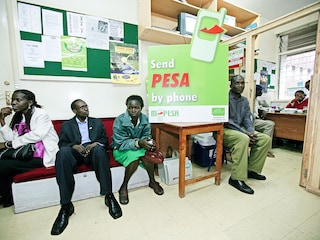How the most resilient companies adapt to disruption
Firms in emerging markets have long operated in uncertainty. What can we learn from them?


Global risks are rising, and many companies are struggling with how to adapt. The World Economic Forum’s 2025 Global Risks Report makes it clear that challenges like escalating global tensions and conflicts, climate change, economic instability and supply chain disruptions are interconnected and build on one another. And they’re here to stay.
Meanwhile, US president Donald Trump’s tariff threats are creating more unpredictability in global trade.
Companies have no choice but to constantly adjust their strategies. For many medium- to large-sized companies in emerging markets, this way of thinking is second nature. Firms often operate in environments with fragile institutions, volatile currencies, unreliable infrastructure and political instability. They have become used to designing strategies with turbulence in mind.
Instead of assuming every piece of the global supply chain will fall into place as planned, and just-in-time strategies will always deliver, these companies have diversified and distributed their operations across multiple regions. They have been quick to build flexible global supply chains, ensuring that if one part of the supply chain is disrupted, other regions can pick up the slack.
While this may seem like common sense, many companies are still finding it difficult to reorganise and adapt to a less predictable and reliable world.
So, how can companies look to build resilience and operate in uncertainty? By taking inspiration from those that have long navigated instability.
Over 17 years of teaching global strategic management, I’ve developed and taught case studies on numerous companies in developing countries that have successfully adapted and reworked their strategies in times of uncertainty. Many of these examples – from Embraer in Brazil, to Haier in China – are featured in my book, Global Strategic Management (Fifth Edition), with more to come in the upcoming sixth edition.
Based on these insights, I suggest six key lessons companies can learn from firms in emerging markets.
A classic example of this is M-Pesa, a mobile payments platform that first launched in Kenya in 2007. Initially it aimed to provide microloans to people without bank accounts. However, when users began using it for money transfers and bill payments, the company quickly adapted to meet this new demand. This ability to learn fast and change direction helped M-Pesa become a leader in mobile payments. It now serves as a global benchmark for success in the industry.
Humility is essential for this kind of swift and effective adaptation. Companies that often face tough, unpredictable conditions tend to approach challenges with a humble attitude. Instead of assuming they have all the answers, they remain open to learning and adjusting.
Natura & Co, the Brazilian cosmetics giant, offers helpful lessons. It has long focused on localising production and sourcing materials from nearby suppliers. Its focus is in the Amazon region, where it works with local communities to sustainably harvest raw materials like aà§aà (purple berries from South American palm trees) and Brazil nut oil. This approach:
For companies like MTN Group, a telecommunications giant based in South Africa, redundancy is a necessity, not a luxury. Investing in backup power solutions and alternative communication links is essential to ensure MTN can maintain services amid frequent power outages.
In critical sectors like telecommunications and technology, parallel networks, alternative energy sources and backup systems ensure uninterrupted operations in the face of infrastructure failures, climate risks or other unforeseen disturbances.
The Tata Group, which operates across multiple industries from steel to software, is perhaps the most prominent example of this.
Another great example is MercadoLibre, Latin America’s leading e-commerce platform, which faced the challenge of fragmented transport networks that made 24- or 48-hour deliveries near impossible. The only way to improve delivery speed was for the company to build its own logistics network. By doing so, it gained greater control over its supply chain, improved its ability to scale and greatly improved delivery reliability.
Dilmah Tea took this hands-on approach by owning tea gardens, factories and packaging facilities in Sri Lanka. The company controls every step of the process, ensuring high-quality, single-origin Ceylon tea while cutting costs and emissions.
This localised approach minimises dependence on external suppliers, protecting them from problems that can arise in global supply chains, like delays or shortages.
This decentralised approach allows teams to swiftly adapt their strategies when disruptions arise. For instance, during the Covid-19 pandemic, Haier maintained operational efficiency by enabling employees at local and product levels to make rapid, informed decisions.
By staying close to users and gathering constant feedback, Haier’s micro-enterprises are able to anticipate potential disruptions before they become major threats and develop products and services that satisfy evolving needs.
While it might not always be possible to completely shift power to individual teams, giving people the freedom to make decisions and take ownership of their work allows them to respond quickly to new challenges and come up with creative solutions.
It all begins with a shift in mindset – recognising these challenges as the new reality and accelerating our own pace of learning and adaptation accordingly.
First Published: Mar 20, 2025, 16:45
Subscribe Now